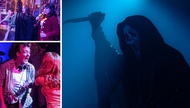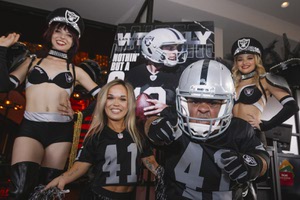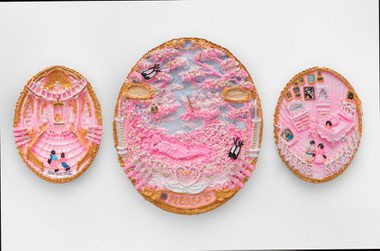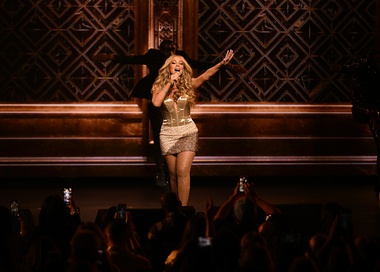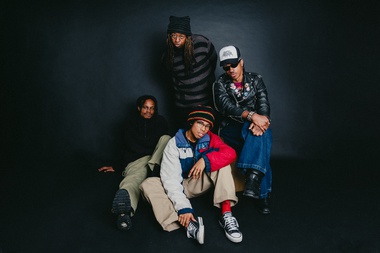It’s 10:30 p.m. on a Saturday night, and I’m pointing a .357 Magnum at the face of the world’s most adorable Chihuahua, Mr. Piffles. I came to see burlesque legend Dusty Summers perform in Vegas Nocturne at the Cosmpolitan’s Rose. Rabbit. Lie., but I’ve been pulled onstage to be part of Piff the Magic Dragon’s act—where I’m about to fire a bullet and hope Mr. Piffles can catch it.
I had heard that Vegas Nocturne was a great showcase for neo-burlesque, but even before I was handed a gun and asked to shoot the world’s most adorable Chihuahua, the show had twisted and turned, and I’m not sure what it’s supposed to be anymore. Turns out that’s pretty par for the course for neo-burlesque.
“Burlesque is a bunch of different things,” says Cha Cha Velour, an award-winning burlesque performer based in Las Vegas. “And definitely, there’s not one exact definition. I mean, if you look in the dictionary, it means a grotesque exaggeration, to make fun of, to make mockery of; and then the second definition is variety show with striptease—but then even that, what’s actually striptease?”
For Velour, burlesque is a combination of dancing, acting, clowning, drag and more. But because of the wide scope of what it can mean, there’s no small amount of contention in the burlesque community about what is, or isn’t, burlesque and who gets to claim it as their own.
Katie Kenner is the director of Twisted Cherry Burlesque, a monthly burlesque revue that takes place at Onyx Theatre, and she has some strong words for anyone trying to draw a line in the sand. “Ladies in the burlesque community, every show that comes up that has the word ‘burlesque’ or ‘pinup’ or anything like that in it, they’re like, ‘That’s not real burlesque!’ And it’s like, hold up, what gives you the right to say that’s burlesque or not? Because they didn’t pick you to perform, that’s not really burlesque? Have you seen Zombie Burlesque? That’s frickin’ great!”
Zombie Burlesque is the brainchild of Las Vegas native David Saxe, the magnate behind the V Theater and Saxe Theater at Planet Hollywood. He’s seen burlesque through the years here—as it has transitioned from vaudeville acts with comedians and skits to parading showgirls to synchronized troupe dancing—and frankly he was over it. He thought the genre was played out, until a planeful of tourists told him otherwise.
“I fell in love with The Walking Dead, so I started digging zombies and I was like, there’s no zombie show,” Saxe says.
He didn’t think people would want to be scared by a live performance, so he decided to flip the equation, playing around with the idea of a “sexy” zombie show on a flight back to town. He wrote down sample titles for a production—Zombie Cabaret, Zombie Follies and Zombie Burlesque.
“I was like—‘burlesque?’ It’s never been done right in this town, in my opinion, and it’s probably over, but I’ll put it down there just to see.” He asked a stewardess to pass the slip of paper around the plane and have passengers vote for the title they liked most. Zombie Burlesque was the clear winner. “It came back with 100 and something marks under Zombie Burlesque, all the other ones had one or two check marks,” Saxe marvels, as if he still can’t believe it. “So I was like, ‘Okay, I’m doing burlesque.’”
Saxe’s vision of burlesque includes stripteases, skits, comedians and speciality acts—and despite its zombie-hipster edge it hews closely to the traditional idea of burlesque as a satiric variety show. The show’s conceit is that the audience is attending something like the zombie version of the Cotton Club—zombies dance, perform and, yes, strip down for a living audience. There’s a live band, comedic sketches (zombies versus the living in a newlywed-style game where the zombies almost always win, thanks to the singularity of their answers—“braaaaains”), dance numbers (including a tender pas de deux between zombies with some clever projection mapping on the dancers’ bodies), a genuinely creepy zombie contortionist and more than a few stripteases. One standout has performer Lora Kelsey dealing with a possessed hand that gets a little too, well, handsy, while Enoch Augustus Scott sings “I Put a Spell on You.”
Dustin M. Wax, executive director of the Burlesque Hall of Fame Museum at Emergency Arts, also doesn’t like to give one standard definition of burlesque—“Our job is to document it as it’s moving forward”—but he does mention “thin lines” that both connect it to and separate it from other aspects of entertainment. And Wax says the idea of comedy and parody go straight to the beginnings of burlesque in America.
“In the 1860s through the 1890s, long before the striptease, the burlesque houses would be in New York on Broadway, across the street from more mainstream production theaters, and they’d have spies,” Wax says. “They would find out what was coming at the theater across the street, and they would write parodies of it to show at the same time. And the easiest and funnest way to parody anything is to add sex to it.”
When this mixture of sex and parody collided with the fourth-wave feminism of the 1990s, the neo-burlesque movement was born. The movement explicitly accepted the transgressive nature of burlesque and turned it into a personally empowering art form. Scott, the host of Zombie Burlesque and a performer in other burlesque (and “boylesque”) shows around town, isn’t afraid to get high-minded about the gender politics behind burlesque.
“In burlesque, the performer is always looking at the audience,” Scott says, “bringing the audience in, challenging the audience.” This dynamic flips the traditional power structure in entertainment, transforming the performer from an object to be ogled into a person with agency, returning the “male gaze.”
“It’s feminine and subversive and powerful,” Scott says.
Wax agrees. “There’s something innately transgressive about women taking control over their own bodies and their presentation and being willing to go onstage and not just take their clothes off but to embody these sexually powerful roles that they take on. To be not insecure. That is already transgressive.”
But forget theory. Chastity Badcock just wants to dance and make you laugh. Early Saturday afternoon she’s rehearsing in Cha Cha Velour’s burlesque classroom studio on Industrial. Badcock’s wearing sweatpants with “Navy” along the legs, a T-shirt and tennis shoes. Her hair’s pulled back, she still carries some baby weight from her last kid and right now she looks less like a shining symbol of feminist empowerment than a mother simply grateful for an hour away from her family.
I’m reminded of what Kenner said about burlesque, that “it’s about celebrating who you are as an entertainer. It’s about being confident in yourself. It’s about loving your own self. And it’s an outlet for those who wouldn’t normally be a performer.”
Badcock is prepping a new routine for Cha Cha’s Smells Like Tease Spirit live burlesque show at Boomers Bar (which took place February 22). In the routine, Badcock strips out of a monkey suit to the Bloodhound Gang’s “The Bad Touch.” (Sample lyric, for the ’90s-impaired: “You and me baby ain’t nothing but mammals/So let’s do it like they do it on the Discovery Channel”).
Cha Cha helps Badcock out with some rough patches in the middle of the song, and they’re batting around ideas for moves (“I’m trying to make it look like I’m not an interpretive dancer”), costumes (“Of course, you can’t wear heels and a monkey suit, that’s just weird”) and what to do with the monkey’s tail (they settle on a tassel at the tip). Badcock’s a graduate of Cha Cha Velour’s 12-week intro to burlesque course, and has decided to keep on dancing.
And she’s not alone. Wax has seen a 20 percent spike in applications for the Burlesque Hall of Fame Weekend’s Movers, Shakers & Innovators Showcase in each of the past four years. “For us to have that kind of growth, you have to have greater growth at the grassroots level across the country. Burlesque has this growing power as an icon,” Wax says, adding that it’s not surprising to see a bit of classic burlesque in the spanking-new Vegas Nocturne, a show that aims to capture the Vegas experience.
That idea, however, runs headlong into Ross Mollison, producer of Vegas Nocturne, who—here it comes—doesn’t think his show has any burlesque acts.
“What we do is not really burlesque as I knew it,” Mollison says. “I think the acts that we do that reference burlesque are incredibly entertaining. They’re really, really fun, they show fabulous artistry and fabulous talent—but that’s the same for pretty much any act we do.”
But not just any act closes the third canto of Nocturne. Two high-octane burlesque numbers do, stoking the energy in the small theater to the point of combustion. First, Angie Sylvia strips out of a fire-engine-red vinyl trench coat and plays with fire. She drags lit torches across her body, swallows fire, lights more torches with her breath and, in a brilliant burlesque moment, uses a torch to burn portions of her costume off her body. It’s hot. Literally.
It could very well be the end of the evening, a spectacular send-off before the space turns into a nightclub, but the burlesque isn’t over. A gray-haired woman in a beige overcoat—who has been seen throughout the night cleaning up after acts and in a silent comedic bit—takes the stage. Entranced by the lights she begins to strip. The apprehension the audience feels at that moment is palpable. And while they look on in shock, burlesque legend Dusty Summers strips off the overcoat to reveal a shimmering, blue, fringed outfit and proceeds to deliver a classic tease routine with a step and a dip and a bump and a grind (and a few other surprises, too). It’s sensual, exotic and absolutely brazen.
Summers started as a go-go dancer in the ’60s, kept performing throughout the ’70s and ’80s and worked as a pit boss at Circus Circus until retiring in the early aughts. The Burlesque Hall of Fame coaxed her out of retirement to perform at its Legends night in 2013, and now she’s performing a jaw-dropping striptease that takes Vegas Nocturne from an outrageous show to a legendary “Oh my God” moment of Vegas lore.
So when Mollison says, “I think it’s very surprising when Dusty comes out. I think the audience is really delighted by that, and it’s not what they expect to see,” it’s an immense understatement. Every time I have seen the show, the crowd simply erupts when Dusty begins to take it off.
“Nowadays, it is not so much about how much you take off, it’s how well you take it off,” Summers tells me over the phone later. She means that about all burlesque, though she notes that, “In my case, my costume covers the things I don’t want anybody to see, and it does it in such an elegant way!” She laughs before continuing. “You’re only showing the part that looks good, so you can maintain that elegance—and it makes the burlesque part ageless.”
Ageless, yes, but also approaching new heights of popularity. No matter the disagreements about what is or isn’t burlesque, it’s clear what it does. When the people in the seats at Rose. Rabbit. Lie. see Dusty strut her stuff, she takes the room from surprise to full-throated support.
Why does it evoke such a strong response? Because good burlesque doesn’t just titillate its audience. It opens up space for the unexpected, the bold and the creative—traits that don’t just belong in blockbuster movies or to certain age groups or privileged classes of people. They belong to everyone. Sexuality is fundamentally democratic, after all, and burlesque suggests that anyone can be fearless, creative and surprising. And if you can be that way with your sexuality, the most rigidly defined of social mores, then maybe you can live the rest of your life that way, too.


